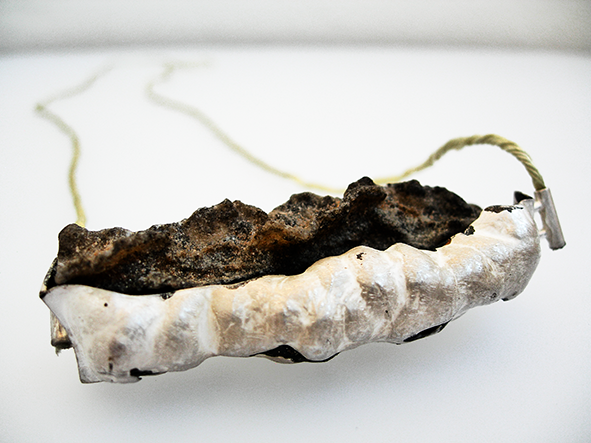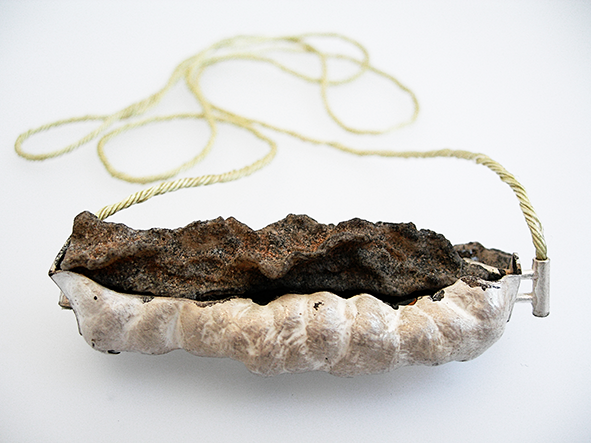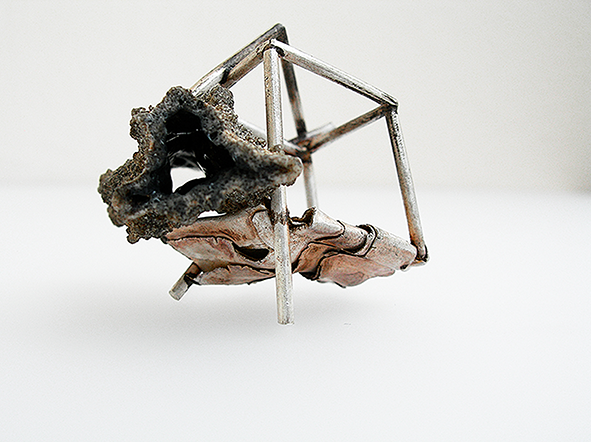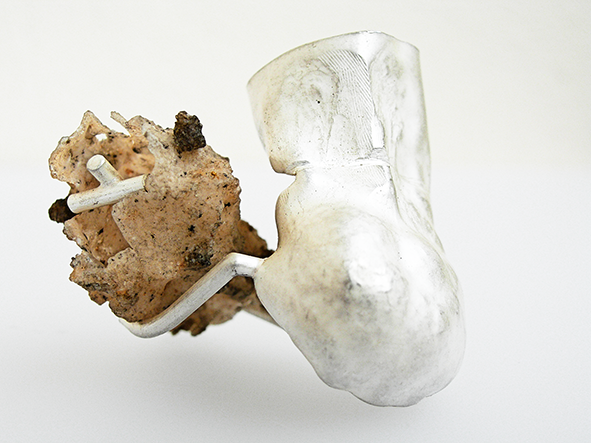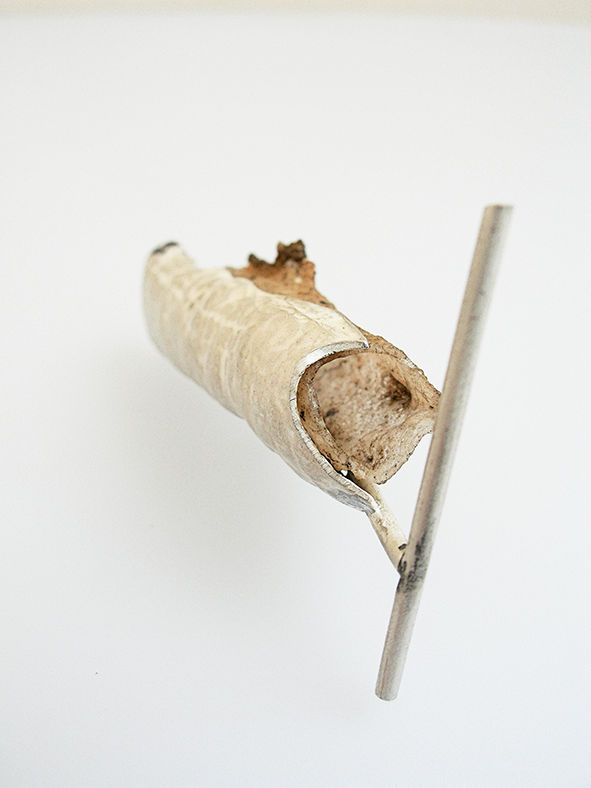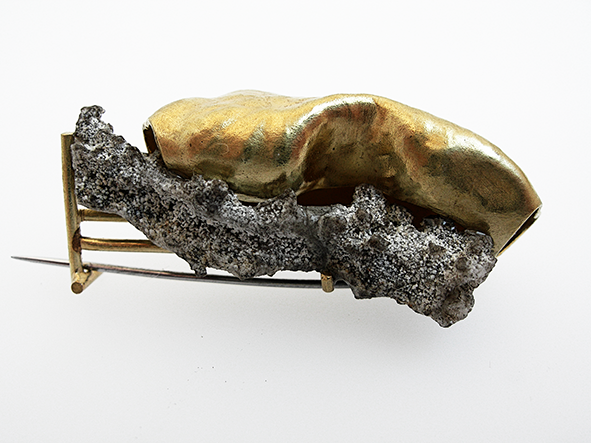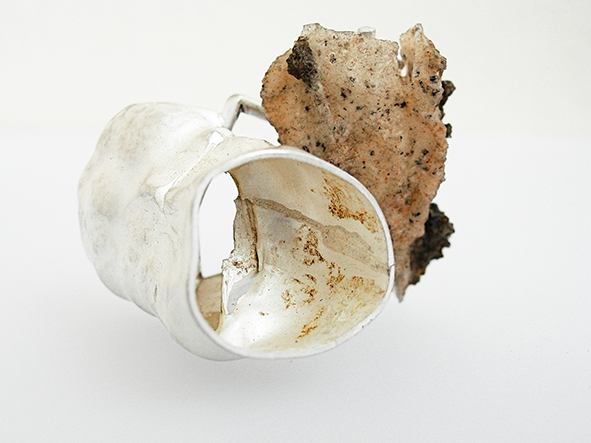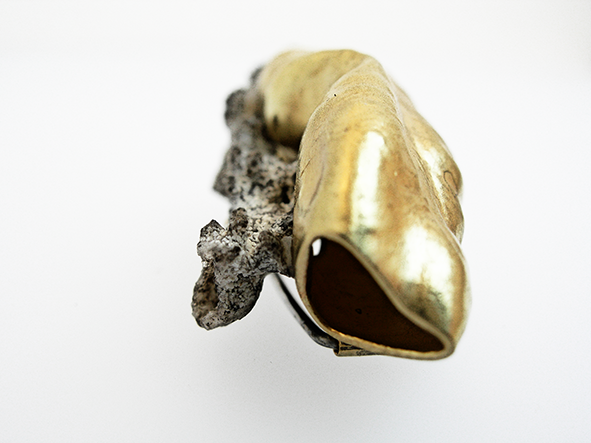T H E D A R K
P R E C U R S O R
International Conference on Deleuze and Artistic Research
DARE 2015 | Orpheus Institute | Ghent | Belgium | 9-11 November 2015
O P E N - A C C E S S R I C H - M E D I A P R O C E E D I N G S
Edited by Paulo de Assis and Paolo Giudici
T H E D A R K
P R E C U R S O R
International Conference on Deleuze and Artistic Research
DARE 2015 | Orpheus Institute | Ghent | Belgium | 9-11 November 2015
O P E N - A C C E S S R I C H - M E D I A P R O C E E D I N G S
Edited by Paulo de Assis and Paolo Giudici
Federica Pallaver
Goldsmith, Bolzano/Bozen, IT
Matter-Flow: Studies of Minor Composition
Day 2, 10 November, Orpheus Penthouse, 9:00-9:30
Among Deleuze’s encounters with art, jewellery has certainly never had any particular relevance, if compared with literature, painting, cinema, or music. And yet, jewellery making and metal arts (metallurgy, smithery, metalworking) more widely, appear at a crucial juncture of A Thousand Plateaus. Not only because of their relation to “nomadism”—“something lights up in our mind,” Deleuze writes, “when we are told that metalworking was the ‘barbarian’ or nomad art par excellence, and when we see these masterpieces of minor art” (Deleuze and Guattari 1987, 401)—but above all because metal is the pure matter-movement, or “matter-flow.” Metal, Deleuze says, is “neither a thing nor an organism, but a body without organs,” the “conductor of all matter” (ibid., 411). The “first and primary itinerant,” then, is the artisan-metallurgist, who follows the flow of matter. Metal arts let emerge “a vital state of matter as such, a material vitalism”: a “nonorganic life” (ibid.). For Deleuze, “Metal is what forces us to think matter, and it is what forces us to think matter as continuous variation” (Deleuze 1979)—that is, as pure “modulation” (in Simondon’s sense). Metal and metal arts, then, allow us to break with the form-matter dualism of the hylomorphic model, typically exemplified by moulding techniques. Instead of a succession of forms and variability of matters, metal arts indeed operate a capture of nonorganic forces through a “continuous development of form” and a “continuous variation of matter” (from which also follows, according to Deleuze, the essential relationship between metallurgy and music). In short, the artisan-metallurgist replaces the static relation, form-matter, with the dynamic relation, “material-forces,” creating properly metallic “affects.”
This conception opens the possibility of a decisive displacement with respect to contemporary jewellery, which remains mostly tied to figuration (or organic representation) and the hylomorphic model by merely reproducing forms and looking for a diversity of materials. The pursuit of this possibility is the attempt of the works I present. The aim is to experiment with a non-hylomorphic approach to matter-flow and the genesis of forms. To this end, I tried to construct an assemblage between two heterogeneous material elements (metal and glass formed by lightning-induced melting of sand) upon which I performed different processes of deformation. The result is a series of “consolidated aggregates,” of “coupled figures,” where the metallic form is not obtained by any casting or moulding operation (such as lost wax casting or electroforming), but primarily by means of one of the most ancient goldsmith’s techniques (though completely liberated from any decorative, figurative, or narrative function), called repoussé, which consists of a continuously variable modulation or folding of thin metal leaves. The genesis of form is thus immanent and topological (instead of transcendent and geometrical), inseparable from forces exerted upon the material. This reveals a “vague” materiality in which forms are not imposed to matter but emerge as intensive affects of the material itself. These works of minor art thus attempt to contribute to the questioning of what Deleuze calls a “phenomenology of matter.”
References
Deleuze, Gilles. 1979. “Metal, metallurgie, musique, Husserl, Simondon. Cours Vincennes 27/02/1979.” Available at: http://www.webdeleuze.com/php/texte.php?cle=185&groupe=Anti%20Oedipe%20et%20Mille%20Plateaux&langue=1 [accessed 1 October 2015]
Deleuze, Gilles, and Félix Guattari. 1987. A Thousand Plateaus: Capitalism and Schizophrenia. Translated by Brian Massumi. Minneapolis: University of Minnesota Press.
Federica Pallaver is a goldsmith living in Bolzano, Italy. After completing her studies in goldsmithing in Florence in 1992, she further studied by working with Giampaolo Babetto in Padua (1992), following courses at the Sommerakademie in Salzburg (Austria) with Robin Quigley (1994) and Erico Nagai (2001), in Florence at Alchimia with Giovanni Corvaja (2006), and in Padua at the Pietro Selvatico Institute of Art with Graziano Visintin (2008). Her works have been displayed in individual and collective exhibitions in Italy, at Prisma gallery (Bolzano), Cristiani gallery (Turin), Ugo Carà Museum of Modern Art (Trieste), Fioretto gallery (Padua), Alchimia (Florence), in Germany, at Oko gallery (Berlin), and Schmuckfrage gallery (Berlin), in England, at the Roundhouse (London), in Lithuania, at AV17 gallery (Vilnius), and Russia, at the Amber Museum (Kaliningrad). In 2010 she was invited to the 13. Erfurter Schmucksymposium in Erfurt (Germany). Since 1996 she owns an atelier in Bolzano.
Email: federica@pallaver.it
One of the main limits I see in contemporary jewellery is that jewellery-artists continue to think of jewel and jewellery-making in terms of the old matter-form dualism. This is the principal reason why I consider absolutely crucial Deleuze’s few pages of A Thousand Plateaus where he speaks of jewellery and metal arts in relation to ‘minor’ and ‘nomad’ art. Indeed, furthering some acute analyses provided by Gilbert Simondon, Deleuze points out how, despite appearances, metal arts have always been irreducible to the matter-form dualism, or the so-called hylomorphic model. According to this model, both the natural and the artificial individuation or production of beings and objects would consist of a fixed, pre-given form which determines and organizes an undetermined matter or even a prepared matter. Not by chance, the paradigmatic example of this conception has always been that of the mould. But, that this idea is completely unreal, a merely abstract representation, immediately appears when we simply note, as Simondon says, that if I put some sand in a mould and then wait a while, I will obtain a sand pile, not a brick. Similarly, when I put melted metal in my mould, or use any traditional or more sophisticated casting or moulding technique (from lost wax casting to electroforming), I literally don’t produce, less and less create, any form. I rather limit and put an end to the potential deformation of the flow of metal. I simply impose to matter a form, because in all these forming methods I always need a model, simple or complicated as I want, even unique. Thus, in fact I continue to re-produce something, but I don’t create anything. In short, as long as I think and work in terms of matter and form, there is absolutely no place for speaking of a genesis of forms. This is why the widespread use in contemporary jewellery of the various techniques of moulding as means of the artistic creation, is in my view an illusion, as long as jewellery-making still remains tied to an hylomorphic thinking and approach to matter.
Interestingly, and even paradoxically, Deleuze ascribes precisely to metal arts a kind of privileged status for breaking with such thinking. This is primarily because in his view metal is the pure matter-movement, or matter-flow. ‘Metal’, Deleuze says, ‘is what forces us to think matter, and it is what forces us to think matter as continuous variation’ (Deleuze 1979). So, while the matter-form dualism in metal arts has always been seemingly the most rigid, on the contrary, he argues, metal arts imply a ‘continuous development of form’ and a ‘continuous variation of matter’ (Deleuze and Guattari 1987: 411). Instead of the imposition of form to matter through a fixed, static, operation of moulding which can be repeated in an ordered succession, metal arts operate a dynamic genesis of form through continuous processes of deformation or modulation of matter. The ‘operations’, Deleuze writes, ‘are always astride the thresholds’, that is, between matter and form, ‘so that an energeticmateriality overspills the prepared matter, and a qualitative deformationor transformation overspills the form’ (410). Thus, the form, we might say, emerges immanently from matter through the forces exerted on it. In this way, Deleuze says, the static relation, matter-form, is replaced by the dynamic relation, material-forces (95, 342, 364, 369).
In the works you can see here, I attempt to follow such a non-hylomorphic approach to metal. As a goldsmith, I have always worked with metals, mainly precious; and, having studied and worked with Giampaolo Babetto in Padua, I have never used any casting or moulding technique. So while I’m not a philosopher, Deleuze’s ideas on jewellery-making and metal arts have been, at least intuitively, immediately clear to me, because they express in concepts, certainly better than I can, what I have always practiced with metal and tried to do with my works. Now, in elaborating these works for this exhibition, the first problem I had was how to make sensible a non-hylomorphic approach to metal; that is, how to render visible a possible way of breaking with the matter-form dualism in favour of a material-forces relation. It is to say, first of all, that the metal I used, silver and gold, is necessarily a prepared matter, thus properly a material. I didn’t go to extract it in a mine, I haven’t used pure silver or gold, but I have prepared a standard alloy, which I then passed in my hand-operated rolling mill, and so on. So the pure matter-flow has undergone from the beginning a series of operations to conferring to metal the necessary plasticity, malleability, and so on. The point now was to attain an immanent genesis of forms following Deleuze’s and Simondon’s idea of a dynamic deformation or modulation of the material, without any model and mould. So I thought that the most direct way to do this was to use, or rather reinvent, one of the most ancient goldsmith’s techniques, called repoussé or repoussage. The French word repoussé means ‘pushed up’, and comes from the Latin ‘pulsare’, ‘to push’, or rather ‘to pulsate’. This meaning perfectly expresses the idea of a dynamic modulation, because the repoussé technique precisely consists of a continuously variable deformation or folding of thin metal leaves, obtained through a rhythmic hammering of the metal with a punch, which is ceaselessly and fluidly ‘pushed up’. This rhythmic gesture is an intensive, pulsating flow, which follows, Deleuze would say, the singularities of the material. The resulting form or shape is therefore truly generated by local variations of the metal, by plastic deformations produced by the forces exerted on it. As I said, the repoussé technique is one of the most ancient in goldsmithery. It was known to the Egyptians and widely used by the Greeks and Romans, for instance. Moreover, and particularly interesting for Deleuze’s discussion of nomadism, there are exemplars of jewels (necklaces, bracelets) and other ornaments (plaques, fibulae) decorated with repoussé technique made by nomadic peoples, famously the Scythians. When I said that in my works I have somehow reinvented such technique, it is because for leading to extreme consequences the break with the hylomorphic model I have attempted to liberate it from any decorative, figurative or narrative function, as it instead was in the ancient use. So not only I haven’t used any casting or moulding technique, but the resulting forms are also liberated from any figuration or organic representation, as Deleuze would say; in other words, they don’t reproduce nor represent anything.
I had, however, a second problem, in addition to the attempt of a non-hylomorphic approach to metal. This is more difficult to explain, because it has to do with something always present in the creative process. I can put it this way: how to render consistent a piece? How to make a work, as Deleuze says, ‘stand up on its own’ (Deleuze and Guattari 1994: 164)? It is no longer a problem of technical composition, but of aestheticcomposition. Now, my way to address this problem in these works is related to how I looked for a link with the main theme of this conference, namely, Deleuze’s concept of the ‘dark precursor’. I haven’t sincerely really understood what this concept means. So my approach has been absolutely intuitive. Nevertheless, in explaining the concept of the ‘dark precursor’, Deleuze makes the example of the lightning, which, he says, ‘flashes’ as a ‘sign’ of a difference of intensity. Deleuze uses the French word ‘foudre’ for lightning, and he often uses the verb ‘fulgurer’ to express how it ‘flashes’. Now, both terms come from the Latin ‘fulgur’, that is, lightning. My idea was then to couple the metal forms with fragments of sand fulgurite, which is a simple, but clear, example of what a lightning, and thus a dark precursor, can produce. Indeed, fulgurites are hollow glass tubes formed by the melting of silica sand induced by lightning strikes. Note that the fragments I have used are not produced artificially; they come from the Mauritanian desert. Thus they are actually fragments of the branched paths of a lightning’s event. The result you can see in these works is therefore a series of ‘consolidated aggregates’, of ‘coupled figures’, constituted by an assemblage between two heterogeneous material elements (metal and glass), and this is the way I did, I hope, stand up alone my works.
There is, finally, a last problem. Beyond the technical composition, the processes operated on the materials, as well as the attempt to make consistent a piece, the problem is how the forces performed on, and embodied in, the materials can render a work able to express what Deleuze calls a bloc ofsensations, or affects. In speaking of metal and metal arts, Deleuze suggests that what is peculiar to them is their capacity to let emerge, he says, ‘a life proper to matter, a vital state of matter as such, a material vitalism’ (Deleuze and Guattari 1987: 411). This is primarily because, he continues, ‘Metal is neither a thing nor an organism, but a body without organs’, so that the proper invention and intuition of metal arts, he says, is the idea of a Nonorganic Life. It is something of this nonorganic vitalism that I have attempted to express; but, whether I succeeded or not, I leave it to you to decide.
References
Deleuze, Gilles. 1979. “Metal, metallurgie, musique, Husserl, Simondon. Cours Vincennes 27/02/1979.” Available at: http://www.webdeleuze.com/php/texte.php?cle=185&groupe=Anti%20Oedipe%20et%20Mille%20Plateaux&langue=1 [accessed 1 October 2015]
Deleuze, Gilles, and Félix Guattari. 1987. A Thousand Plateaus: Capitalism and Schizophrenia. Translated by Brian Massumi. Minneapolis: University of Minnesota Press.
Deleuze, Gilles and Guattari, Félix (1994) What is philosophy?, trans. Hugh Tomlinson and Graham Burchell, New York: Columbia University Press.


